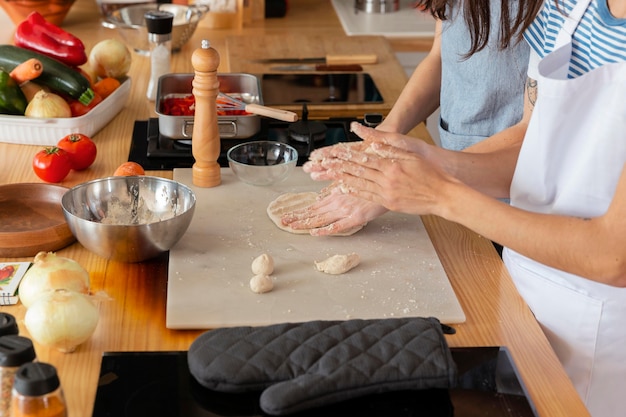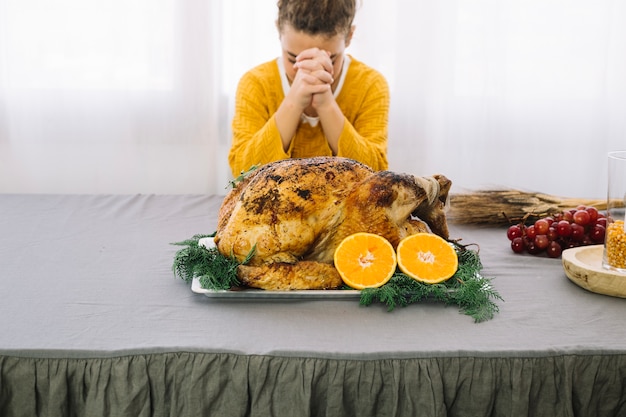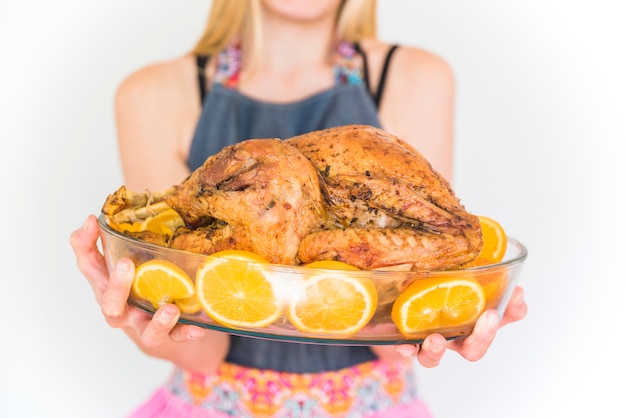Forget the stress and mystery surrounding turkey cooking! Let's demystify the art of roasting a turkey with a secret weapon: the humble turkey cooking bag. I've been a convert for years, and it's changed my Thanksgiving game for the better. This isn't your grandma's roast turkey, this is a modern marvel, a culinary shortcut that delivers a juicy, flavorful bird with minimal fuss. The best part? It's incredibly easy! No more agonizing over basting every half-hour or wondering if your bird will be dry and overcooked. With the bag method, you can relax and enjoy the festive atmosphere, knowing your turkey is taking care of itself.
Get ready to dive deep into the world of turkey cooking bags! We'll cover the basics, the benefits, the equipment you'll need, and the all-important cooking times. I'll even share some of my favorite tips and tricks for achieving the perfect roast turkey, guaranteed to impress. But first, let's get personal, shall we?
(Part 1) My Turkey Cooking Journey

Like most people, I've had my fair share of turkey mishaps. I've tried every method under the sun, from traditional roasting to using a turkey roaster. But, my turkey dreams weren't truly fulfilled until I discovered the turkey cooking bag.
It was a Thanksgiving a few years back. The pressure was on, the family was coming over, and I was staring at a giant turkey, feeling completely out of my depth. My sister, a culinary whiz, suggested I try a turkey cooking bag. I was skeptical. A bag? How could that possibly work? But desperate times call for desperate measures, so I gave it a go. And let me tell you, it was a revelation! The turkey was the most moist and flavorful I'd ever made, and it was so easy. I couldn't believe I hadn't tried it sooner!
(Part 2) Why Choose a Turkey Bag?

So, why are turkey cooking bags a culinary game-changer? Let's break down the benefits:
2.1. The Magic of Moisture
The number one reason I love turkey bags is the moisture they lock in. The bag traps the turkey's natural juices, creating a steamy environment that keeps the meat incredibly moist and tender. Forget about dry turkey breast, the dreaded turkey-crime that plagues many a thanksgiving dinner. With a bag, you're guaranteed a juicy, flavorful bird, no matter how long you cook it.
2.2. Say Goodbye to Mess
Another huge plus is the reduced mess. I'm talking about no more drippy pans, no more splattered oven walls, and no more scrubbing for hours after dinner. The bag acts like a self-contained unit, keeping all the juices and drippings inside. This means a cleaner oven and less time spent cleaning up after your feast. You can focus on enjoying your meal instead of cleaning up.
2.3. Simple and Easy
Let's be real, nobody wants to spend hours slaving over a hot oven on Thanksgiving. That's where the simplicity of the bag method comes in. You basically just stuff the turkey, seal it in the bag, and pop it in the oven. No basting, no turning, just pure, effortless turkey cooking. The bag does all the hard work, leaving you free to relax and enjoy the holiday.
2.4. Flavor Enhancement
The bag method isn't just about moisture; it's also about amplifying flavour. The enclosed steamy environment helps to infuse the turkey with the flavours of the herbs and spices you add. It's like a mini-sauna for your turkey, creating a delicious flavour explosion.
2.5. More Than Just a Turkey
You know what else is great about turkey bags? They're not just for turkeys! You can use them to cook other poultry, like chicken or duck, and even roasts like beef or pork. So, you can get creative and expand your culinary repertoire with this versatile tool.
(Part 3) Choosing the Right Turkey Bag

You've decided to jump on the turkey bag bandwagon, great! But, there's a slight catch. Not all turkey bags are created equal. You want to make sure you're using a bag that's safe, durable, and compatible with your cooking method.
3.1. Safety First
Safety is paramount, so choose a bag that's made from food-grade materials, specifically designed for cooking. Look for bags that are BPA-free and have a heat-resistant seal. It's also a good idea to check for a seal of approval from a reputable organization. A quick glance at the packaging will give you a good idea of the bag's safety and quality.
3.2. Size Matters
You need a bag that's big enough to comfortably hold your turkey, leaving some room for air circulation. If you're cooking a smaller bird, you can opt for a smaller bag. But, if you're tackling a turkey behemoth, go for a large bag to ensure there's enough space for even cooking. A cramped bag can result in uneven cooking and a less than ideal turkey.
3.3. Oven or Stovetop?
Some bags are designed for oven cooking, while others are meant for stovetop use. Make sure the bag you choose is compatible with your cooking method. Check the packaging for instructions and be sure to select the bag that's right for your preferred cooking method.
3.4. Don't Forget the Ties
Most bags come with ties for securing them. You want strong, reliable ties that won't give way during cooking. If you're using a bag without ties, you can improvise with kitchen twine or rubber bands. Make sure your ties are secure to prevent any leaks or spills.
3.5. Read the Label
Finally, always read the label! This is your guide to understanding the bag's features, safety guidelines, and cooking instructions. Make sure you know how to use the bag correctly and safely. It's your roadmap to a successful turkey cooking experience.
(Part 4) Essential Equipment
Before you embark on your turkey cooking bag adventure, you'll need a few essential tools to make the process smooth and efficient.
4.1. A Big Enough roasting pan
You'll need a roasting pan that's large enough to hold the turkey bag comfortably, with some space around it for even cooking. Look for a pan with a rack or a trivet to lift the bag off the bottom. This helps ensure even heat distribution and prevents the bag from burning.
4.2. A Sharp Knife
This is for preparing your turkey and making any necessary cuts. A sharp knife will make the process easier and safer. A dull knife can lead to uneven cuts and a frustrating prep experience.
4.3. Kitchen Twine or Rubber Bands
If your bag doesn't come with ties, you'll need kitchen twine or rubber bands to secure the bag tightly. You can also use these to tie the turkey's legs together, which helps it cook more evenly. Secure ties are essential for preventing leaks and maintaining the bag's integrity during cooking.
4.4. Oven Mitts
These are essential for handling the hot bag and roasting pan. Safety first! Hot ovens and roasting pans are no joke. Always use oven mitts to protect your hands and avoid burns.
(Part 5) The Turkey Prep
Now that you have your bag and your equipment, it's time to get your turkey ready for its bag-cooking adventure.
5.1. Brining Your Turkey
This is optional, but I highly recommend brining your turkey. Brining adds moisture and flavour to the meat, resulting in a juicier, tastier bird.
You can make a simple brine solution using salt, sugar, and water. Submerge your turkey in the brine for several hours, or even overnight, for maximum moisture infusion. For a basic brine, mix 1 cup of salt, 1 cup of sugar, and 1 gallon of water. A well-brined turkey will be incredibly moist and flavorful, a culinary dream come true.
5.2. Patting It Dry
After brining, pat the turkey dry with paper towels. This is crucial for achieving crispy skin.
5.3. Stuffing Time
If you're making stuffing, this is the time to stuff the turkey cavity. Be sure not to overstuff, as it can hinder even cooking. Overstuffed turkeys can lead to uneven cooking and a potentially raw center. Keep your stuffing in check for a perfectly cooked bird.
5.4. Seasoning Your Turkey
Season your turkey liberally with herbs and spices. Use your favourite blend or try something new. I love using rosemary, thyme, sage, garlic powder, and black pepper.
5.5. Trussing the Turkey
Tie the turkey's legs together with kitchen twine. This helps it cook more evenly and keeps it from splaying out in the bag. Trussing your turkey keeps it neat and tidy for even cooking.
(Part 6) Cooking the Turkey
You've prepped your turkey, you've got your bag and your roasting pan, now it's time to cook!
6.1. Oven-Cooking
Preheat your oven to the temperature specified on the bag instructions, usually around 325°F (165°C).
Place your roasting pan with the turkey bag inside on the middle rack of the oven. Make sure the bag is not touching the sides of the pan or the oven walls.
6.2. Stovetop Cooking
If you're using a bag for stovetop cooking, follow the specific instructions on the packaging. It typically involves placing the bag in a large pot filled with water and simmering until the turkey is cooked through.
6.3. Cooking Time
Now, the moment of truth: how long to cook that turkey? The cooking time depends on the size of the turkey. A good rule of thumb is to allow 10-15 minutes per pound.
For example, a 12-pound turkey would take around 2-3 hours to cook. But remember, always check the bag instructions for specific cooking times and temperature recommendations.
| turkey weight | Cooking Time |
|---|---|
| 8-10 pounds | 1 hour 45 minutes - 2 hours 15 minutes |
| 10-12 pounds | 2 hours - 2 hours 30 minutes |
| 12-14 pounds | 2 hours 30 minutes - 3 hours |
| 14-16 pounds | 3 hours - 3 hours 30 minutes |
6.4. Checking for Doneness
To check if your turkey is cooked through, use a meat thermometer. The turkey is considered safe to eat when the internal temperature reaches 165°F (74°C) in the thickest part of the thigh.
If the turkey isn't cooked through, continue cooking it for another 15-20 minutes.
(Part 7) Turkey Bag cooking tips
You're almost there! Here are some tips for achieving the perfect turkey in a bag:
7.1. Don't Overcrowd
Make sure there's enough space in the bag for the turkey to cook evenly. Don't overcrowd the bag with too much stuffing or other ingredients.
7.2. Keep an Eye on the Bag
While the bag is cooking, keep an eye on it to make sure it doesn't leak or burst. If you notice any signs of leaking or a rupture, it's best to transfer the turkey to a roasting pan and continue cooking it in the oven, basting with the pan juices.
7.3. Don't Open the Bag Too Soon
Let the turkey rest in the bag for about 10 minutes after cooking. This allows the juices to redistribute throughout the meat, resulting in a juicier turkey.
7.4. Use a Sharp Knife
When you're ready to carve the turkey, use a sharp knife to make clean cuts and avoid tearing the meat.
(Part 8) FAQs
Let's address some common questions you might have about turkey cooking in a bag:
- Q: Can I reuse the turkey bag? A: No, you should not reuse the turkey bag. The bag is designed for single use and should be discarded after cooking.
- Q: What if the bag leaks? A: If the bag leaks, it's best to transfer the turkey to a roasting pan and continue cooking it in the oven, basting with the pan juices.
- Q: Can I use a turkey bag in the microwave? A: No, turkey bags are not designed for microwave use.
- Q: Can I freeze a cooked turkey in a bag? A: It's best to avoid freezing cooked turkey in the bag. The bag can break down in the freezer, and the turkey might become freezer burn. To freeze your cooked turkey, it's best to remove it from the bag and wrap it tightly in plastic wrap or aluminum foil.
- Q: Is it safe to cook a turkey in a bag without brining? A: Yes, it's safe to cook a turkey in a bag without brining. But, brining adds moisture and flavour, so it's recommended if you want a juicier, more flavorful turkey.
(Part 9) Your Turkey Feast Awaits!
And there you have it! You're now equipped with the knowledge and confidence to cook a delicious turkey in a bag. Remember, this is a simple, foolproof method that takes the stress out of holiday cooking. So, relax, enjoy the process, and prepare to impress your guests with a juicy, flavorful turkey that's sure to be the star of the show.
Happy cooking, and happy holidays!
Now, I'd love to hear from you! Have you ever cooked a turkey in a bag? What are your favourite tips and tricks? Share your experiences in the comments below!
Everyone is watching

Corn on the Cob: The Ultimate Guide to Perfectly Cooked Ears
Healthy MealsAh, corn on the cob. Just the name evokes images of sunny days, barbecues, and that sweet, juicy flavour that ...

Scallops: The Ultimate Guide to Perfect Cooking
Healthy MealsAh, scallops. Those delicate, sweet, and utterly delicious morsels of the sea. They hold a special place in my...

Spaghetti Squash: The Ultimate Guide to Cooking and Serving
Healthy MealsRemember that time you saw spaghetti squash at the supermarket, looking all bumpy and strange, and thought, "W...

Salmon Cooking Times: Perfect Guide for Every Recipe
Healthy MealsLet me tell you, cooking salmon is an art form. It's all about getting that perfect balance: juicy and tender,...

Ham Cooking Time: How Long to Bake, Smoke, or Boil a Delicious Ham
Healthy MealsAh, ham. It's a classic, isn't it? A real crowd-pleaser, especially around holidays. And when done right, it'...
